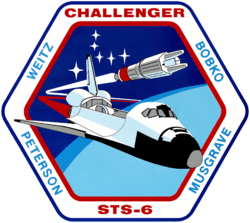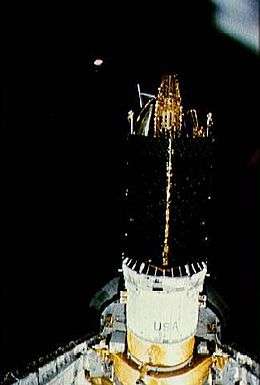STS-6
|
Challenger begins her maiden flight | |||||
| Mission type | Satellite deployment | ||||
|---|---|---|---|---|---|
| Operator | NASA | ||||
| COSPAR ID | 1983-026A | ||||
| SATCAT № | 13968 | ||||
| Mission duration | 5 days, 23 minutes, 42 seconds | ||||
| Distance travelled | 3,370,437 kilometers (2,094,292 mi) | ||||
| Orbits completed | 81 | ||||
| Spacecraft properties | |||||
| Spacecraft | Space Shuttle Challenger | ||||
| Launch mass | 116,457 kilograms (256,744 lb) | ||||
| Landing mass | 86,330 kilograms (190,330 lb) | ||||
| Payload mass | 21,305 kilograms (46,969 lb) | ||||
| Crew | |||||
| Crew size | 4 | ||||
| Members |
Paul J. Weitz Karol J. Bobko Story Musgrave Donald H. Peterson | ||||
| EVAs | 1 | ||||
| EVA duration | 4 hours, 17 minutes | ||||
| Start of mission | |||||
| Launch date | 4 April 1983, 18:30:00 UTC | ||||
| Launch site | Kennedy LC-39A | ||||
| End of mission | |||||
| Landing date | 9 April 1983, 18:53:42 UTC | ||||
| Landing site | Edwards Runway 22 | ||||
| Orbital parameters | |||||
| Reference system | Geocentric | ||||
| Regime | Low Earth | ||||
| Perigee | 288 kilometers (179 mi) | ||||
| Apogee | 295 kilometers (183 mi) | ||||
| Inclination | 28.5 degrees | ||||
| Period | 90.4 minutes | ||||
| Epoch | 6 April 1983[1] | ||||
  L-R Peterson, Weitz, Musgrave, Bobko
| |||||
STS-6 was the sixth NASA Space Shuttle mission and the maiden flight of the Space Shuttle Challenger. Launched from Kennedy Space Center on 4 April 1983, the mission deployed the first Tracking and Data Relay Satellite, TDRS-1, into orbit, before landing at Edwards Air Force Base on 9 April. STS-6 was the first Space Shuttle mission during which a spacewalk was conducted, and hence was the first in which the Extravehicular Mobility Unit (EMU) was used.
Crew
| Position | Astronaut | |
|---|---|---|
| Commander | Paul J. Weitz Second and last spaceflight | |
| Pilot | Karol J. Bobko First spaceflight | |
| Mission Specialist 1 | F. Story Musgrave First spaceflight | |
| Mission Specialist 2 | Donald H. Peterson Only spaceflight | |
STS-6 was the last shuttle mission with a four-person crew until STS-135, the final shuttle mission, which launched on 8 July 2011. Commander Paul Weitz had previously served as Pilot on the first Skylab mission, where he lived and worked in Skylab for nearly a month from May to June 1973. After Skylab, Weitz became the Deputy Chief of the Astronaut Office under Chief Astronaut John Young. Bobko originally became an astronaut for the Air Force's Manned Orbiting Laboratory program but later joined NASA in 1969 after the MOL program's cancellation. Prior to STS-6 he participated in the Skylab Medical Experiment Altitude Test and worked as a member of the support crew for the Apollo-Soyuz Test Project.
Peterson was also a transfer from the MOL program, and was a member of the support crew for Apollo 16. Musgrave joined NASA in 1967 as part of the second scientist-astronaut group, and was the backup Science Pilot for the first Skylab mission. He also participated in the design of the equipment that he and Peterson used during their EVA on the STS-6 mission.
Support crew
- Roy D. Bridges Jr. (entry CAPCOM)
- Mary L. Cleave
- Richard O. Covey (ascent CAPCOM)
- Guy S. Gardner
- Jon A. McBride
- Bryan D. O'Connor
Spacewalks
- Musgrave and Peterson
- EVA Start: 7 April 1983
- EVA End: 8 April 1983
- Duration: 4 hours, 17 minutes
Crew seating arrangements
| Seat[2] | Launch | Landing |  Seats 1–4 are on the Flight Deck. Seats 5–7 are on the Middeck. |
|---|---|---|---|
| S1 | Weitz | Weitz | |
| S2 | Bobko | Bobko | |
| S3 | Musgrave | Musgrave | |
| S4 | Peterson | Peterson | |
Mission background
The new orbiter was rolled out to LC-39A on a fog-shrouded morning in November 1982. On December 18, Challenger was given a PFRF (Pre Flight Readiness Firing) to verify the operation of the main engines. The PFRF lasted for 16 seconds. Although engine operation was generally satisfactory, telemetry data indicated significant leakage of liquid hydrogen in the thrust section. However, it was not possible to determine the location of the leak with certainty, so program directors decided on a second PFRF with added telemetry probes. It was known that during the test run on December 18, that recirculated exhaust gases and vibration leaked into the thrust section and this was considered a potential cause of the leak. Therefore the original planned launch in late January 1983 had to be postponed.
On January 25, a second PFRF was conducted which lasted 23 seconds and exhibited more hydrogen leaks. Eventually, it was found that low pressure ducting in the #1 engine was cracked. The engine was replaced by a spare, which was found to also have leaks. A third engine had to be ordered from Rocketdyne, and after thorough testing, turned out to be in proper operating condition. The #2 and #3 engines turned out to have leaks as well, and were taken out of the orbiter for repairs. By mid-March, the engine problems had been completely resolved.[3]
While the engine repairs were underway on 28 February, a severe storm caused contamination of the mission's primary cargo, the first Tracking and Data Relay Satellite, TDRS-1, while it was in the Payload Change-out Room on the Rotating Service Structure at the launch pad. Consequently, the satellite had to be taken back to its checkout facility, where it was cleaned and rechecked. The Payload Change-out Room and the payload bay also had to be cleaned. All of these events pushed the launch back from 26 March to early April.[4]
Mission summary
On 4 April 1983, STS-6, the first mission of the orbiter Challenger, lifted off at 13:30 EST. It marked the first use of a new lightweight external tank and lightweight SRB casings.
STS-6 carried a crew of four – Paul J. Weitz, commander; Karol J. Bobko, pilot; Story Musgrave and Donald H. Peterson, both mission specialists. Using new spacesuits designed specifically for the Space Shuttle program, Musgrave and Peterson successfully accomplished the program's first extravehicular activity (EVA) on 7–8 April 1983, performing various tests in the orbiter's payload bay. Their spacewalk lasted 4 hours and 17 minutes.
Although the 2,300-kilogram (5,000 lb) TDRS satellite was successfully deployed from Challenger, its two-stage booster rocket, the Inertial Upper Stage (IUS), tumbled out of control, placing the satellite into a low elliptical orbit. However, the satellite contained extra propellant beyond what was needed for its attitude control thrusters, and during the next several months, its thrusters were fired at carefully planned intervals, gradually moving TDRS-1 into its geosynchronous operating orbit, thus saving the $100-million satellite. Other STS-6 payloads included three GAS canisters and the continuation of the Mono-disperse Latex Reactor and Continuous Flow Electrophoresis experiments.
Challenger returned to Earth on 9 April 1983 at 10:53 am PST, landing on Runway 22 at Edwards Air Force Base. During the mission, it completed 80 orbits, traveling 2 million miles in 5 days, 23 minutes and 42 seconds. It was flown back to KSC on 16 April 1983.
 TDRS-A is deployed.
TDRS-A is deployed. Musgrave during the EVA.
Musgrave during the EVA. Musgrave, left, and Peterson float in Challenger's payload bay during the EVA.
Musgrave, left, and Peterson float in Challenger's payload bay during the EVA. Challenger lands at Edwards AFB on April 9, 1983.
Challenger lands at Edwards AFB on April 9, 1983.
Mission insignia
The six white stars in the upper blue field of the mission patch indicate the flight's numerical designation in the Space Transportation System's mission sequence.
Wake-up calls
NASA began a tradition of playing music to astronauts during the Gemini program, and first used music to wake up a flight crew during Apollo 15. Each track is specially chosen, often by the astronauts' families, and usually has a special meaning to an individual member of the crew, or is applicable to their daily activities.[5]
| Flight Day | Song | Artist/Composer |
|---|---|---|
| Day 2 | "Cadets on Parade" | Air Force Academy Band |
| Day 3 | "Teach Me Tiger" | April Stevens |
| Day 4 | "Theme from F Troop" | William Lava |
| Day 5 | "The Poor Co-pilot" | Oscar Brand |
| Day 6 | "Ode to the Lions" | Rusty Gordon |
See also
References
![]() This article incorporates public domain material from websites or documents of the National Aeronautics and Space Administration.
This article incorporates public domain material from websites or documents of the National Aeronautics and Space Administration.
- ↑ McDowell, Jonathan. "SATCAT". Jonathan's Space Pages. Retrieved 20 March 2014.
- ↑ "STS-6". Spacefacts. Retrieved 26 February 2014.
- ↑ http://www.americaspace.com/?p=33504
- ↑ Evans, Ben (2007). Space Shuttle Challenger: Ten Journeys Into the Unknown. Praxis Publishing. p. 26. ISBN 0-387-46355-0.
- ↑ Fries, Colin (25 June 2007). "Chronology of Wakeup Calls" (PDF). NASA. Retrieved 13 August 2007.
NASA to Market Spheres Made in Weightless Space By Thomas O'Toole Washington Post Staff Writer The Washington Post; May 2, 1984; pg. A4
Re: my earlier edit about the first thing manufactured and sold in space
External links
- STS-6 mission summary. NASA.
- STS-6 video highlights. NSS.